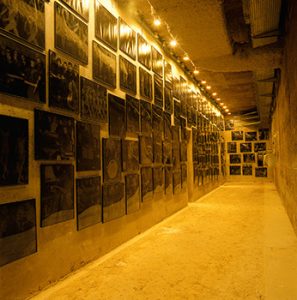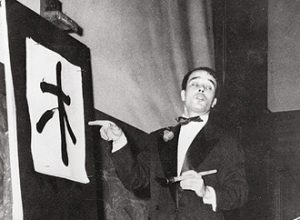
In 1991, Christian Boltanski created a work in one of the crawl spaces of the Conservatoire National Supérieur de Musique et de Danse of Paris. Hidden away, it preserves a memory—both real and fictional—of the institution’s students and rejected applicants. Drawing on this work, Déborah Laks unfolds a unique reflection that intertwines teaching and artistic creation, encouraging us to reconsider one through the lens of the other. In doing so, she invites us to learn and view Boltanski’s work differently, where the role of fable and narrative is closely tied to a desire for transmission, and where, at times, a curious kinship between the artist and the student becomes apparent.
Laurence Bertrand Dorléac et Thibault Boulvain
Déborah Laks Teaching imagination: the hidden depths of the Boltanski studio
In 1991, Christian Boltanski created an installation in one of the crawl spaces of the Conservatoire de Musique et de Danse in Paris. Commissioned by architect Christian Portzamparc as part of the state program “1%”, this installation is not easily accessible to the public, and has, thus, been shrouded in myth and rumors, which constantly re-invent it. Les Réserves du Conservatoire is typical of Boltanski’s approach: comprised of several rooms, it offers a journey through archives: first, photographic, then paper. Just like the archival boxes bearing names and date, the enlarged, dimly-lit images suggest a multitude of former students. United in their competitive drive to enter the best schools, in their representation, in their artistic drive and search for excellence, these names also suggest lost illusions and falls into obscurity. The use of enlarged photographs and archival boxes, as well as the evocation of the processes of memory and the tension between the individual and the collective, place this work at the heart of Boltanski’s approach. Formally and thematically, it follows in the footsteps of contemporary works such as the one on the archives of the Carnegie International (1991) and the Réserve des Suisses morts (1990), as well as earlier works such as the Portrait des élèves du C.E.S Lentillères (1973).

Christian Boltanski, The Music Conservatory Reserve, 1991, installation, Etablissement public du parc et de la grande halle de la Villette, Paris.
Christian Boltanski created this work when he was a professor at the École des Beaux-Arts in Paris. The artist taught for 23 years in Paris (from 1986 to 2009), and previously at the Beaux-Arts in Bordeaux from 1979. His teaching practice is rarely mentioned, either in texts devoted to him or in his interviews. This silence is significant, even though it was not uncommon, particularly at the time, for acclaimed artists to also pursue a parallel and much less considered career teaching in art schools. In order to compensate for the absence of direct testimonials from the artist and the scarcity of archives on the matter, this research is based on a series of 14 interviews I conducted with former students of Boltanski, at the Beaux-Arts of Bordeaux and Paris 1The quotes without an endnote refer to a series of interviews led between September 2023 and February 2024.. All agreed that Boltanski taught in a similar way than he created. The construction of an “individual mythology”, the fabrication and erosion of memories, the place of individuals within the mass, are as much part of his work than they are of this teaching. One temptation would be to consider the latter as a work in its own right. This would be an oversimplification, for the discussions, stories and anecdotes on which he based his teachings are both a continuation of his artistic work and a step aside from it. Looking at his work from the point of view of his teaching, with all that this entails in terms of representation, introspection and openness to others, allows for multiple insights.
Lost illusions
Les Réserves du conservatoire, because it focuses on young artists, and, more precisely, how they were forgotten, is a specific example of this. All of their faces and all of their bodies blend into a whole where individuality disappears. And yet, it seems as though this work partially shifts the focus compared to Boltanski’s other creations, such as Les Suisses morts: the individuals represented or suggested here are young, aspiring artists. Each box bears a single date, spread over a decade: one imagines, because of the context, that these dates represent an admission to the Conservatory. The beginning of an artist’s life, the joys and challenges of training and emulation. Mostly, hope. It is the essence of youth that Boltanski captures in passing and seals within a mastaba hidden in the depths of the great dream factory that is the Conservatoire. The acknowledgment of anonymity is bitter, summarizing and containing lost hopes and stunted paths. Positioned here, this work plays a role akin to that of a crypt in a church. Relics preserved beneath the choir bestow their protective aura upon the faithful gathered above. The artist’s work with light enhances this reference, in the only room without electric lighting, through both the semi-darkness and the initial opening carved into the wall. The piece undoubtedly functions as a memento mori. Speaking of Portrait des élèves du C.E.S Lentillères, Boltanski stated, “Ten years later, all those children’s faces seemed like corpses to me. The portraits are truly dead, and forever, for they are now adults” 2Quoted in L. Gumpert, Christian Boltanski, Paris, Flammarion, 1992, p. 84.. But here, as at Lentillères, it is not an archive of death, even if the bunk-like shelves of archives in the third room are chilling. Boltanski does not suggest the disappearance of individuals, but rather the disappearance of their dreams. The atmosphere of the work also hides a deeply satirical dimension. The stereotypical poses in the photographs mock societal expectations and trends more than they do the young artists themselves. The archive boxes list names of gangsters, politicians, artists, and playful jokes where one finds a B. Sorbitol next to an M. Bourré and an S. M. Soulé 3The pun would translate as M. Wasted and S. M. Tippler..
Hidden 4D. Riout, Portes closes et œuvres invisibles, Paris, Gallimard, 2019., almost never photographed and hardly ever visited, the work reaches a state of underdetermination that places individual imaginations and projections at the heart of its story. Popular culture worms its way into it through names borrowed from cinema and current events, like a heady melody from the contemporary world. Boltanski once said: “I am especially interested in the evolution of the work and its transformation through (oral) storytelling. My desire is for the work to be continuously reinterpreted, performed,” before stating, “I have the desire, perhaps impossible, to create new myths that are not necessarily based on visual elements, to create something that can exist after me, in the shape of a story”5Christian Boltanski, Faire son temps, exhibition cat, Paris, 2019, p. 92 and p. 95.. The Réserve du Conservatoire aligns perfectly with this vision. Indeed, the work primarily exists through its narrative. It is a rumor among students at the school, an anecdote shared by the lucky few who have visited it, likely thrilled by the exclusivity of the place. Storytelling is a modality—perhaps the central modality—of its existence. It constructs, evolves, and recreates the work in the image of the present.
Making an impression
Teaching, too, resides in the memory—recombined, assimilated, and reinvented through otherness and time. Virgil Vernier, a former student of Boltanski in Paris, observes that : “he knew, as he taught, that one day people would recount his lessons. His stories had to be at least mythical or legendary”. Within the academic context of the École des Beaux-Arts in Paris, where technical and artistic classes are separated, workshop leaders stand out as mentors: it is through their guidance that students learn what it means to be an artist. Whether as role models or counterexamples, they are the students’ first objects of study. In one of the rare testimonies on his teaching practice, Boltanski tells Catherine Grenier: “I believe students have nothing to learn, but it is very important for them to know an artist and to see them in their daily life. To know that I smoke a pipe, that I always repeat the same stories, etc. From their observations, they must come to understand for themselves what their own ‘subject’ is” 6C. Grenier, La Vie possible de C. Boltanski, Flammarion, Paris, 2011, p. 249.. The anecdotes at the heart of Boltanski’s teaching are anything but disembodied or abstract: a number of material and sensory details are recurrent in nearly all the interviews I conducted. Everyone recalls a workshop devoid of furniture. Classes took place sitting on the floor around Boltanski, who smoked a pipe and spoke all the more softly when the topics were significant. Francisco Ruiz de Infante describes it as a “somewhat secret, bizarre atmosphere,” and, for all my interviewees, these anecdotal and sensory elements heightened a sense of belonging and uniqueness. Students seem to retain almost synesthetic impressions of these moments. Several recall the light and Clémentine Mélois recounts, “At dusk, if we were in his studio, he would have us turn off the lights and wait for a barge to pass on the Seine. The studio overlooked the river. The barge’s headlights would cast shadows of the railings, the window frames. He would say it was the ancestor of cinema. And we would all sit silently, watching these large shapes move across the studio wall. It was very beautiful. And later, it reminded me of the works he made with wire-frame figures. All of it, all of it is connected.” Between Boltanski’s work, his demeanor, his discourse, the stories and anecdotes he told and repeated, something like a sense of necessity emerged; as though he were performing for his students the idea of continuity between life and art. Jakob Gautel recalls that Boltanski “played, almost staging himself. (…) At first, you take it as truth, and then you realize it’s also a stance, a way of positioning yourself in the world, a posture. There is, of course, an element of teaching in that. I think this is also present in Boltanski’s work. His teaching is very, very close to his art, I believe.” The artist teaches who he is, and he teaches how to create oneself. Angelika Markul puts it this way: “Ultimately, it’s about a story. You have to create a story. Create a mythology for yourself.” From this perspective, the creative process involves an intimate exploration leading to the identification of a self-narrative, grasping it as raw material, kneading it until it stretches, rendering it supple enough to become collective.
This “profound belief of the artist” is brought to light through the connection between creating and teaching: “the only status of existence for the real is the fable, since narration is the sole means of transmission” 7C. Grenier (ed. by), Christian Boltanski, Flammarion, Paris, 2011, p.18.. The narrative enables the balancing of seriousness and satire. The image that Boltanski cultivates and from which he teaches accentuates elements he had already underscored in bold strokes in his Saynètes comiques of 1974. The artist seated on the floor, urging his students to watch Little House on the Prairie as a way to nurture creative fallow fields, is he not also posing—much like the young concert musicians and dancers in the staged photographs of Réserves du Conservatoire? The devouring hopes and disappointments of young people dreaming of making it are shared by the conservatory students, the students of the École des Beaux-Arts in Paris, and Boltanski himself.
[1] The quotes without an endnote refer to a series of interviews led between September 2023 and February 2024.
[2] Quoted in L. Gumpert, Christian Boltanski, Paris, Flammarion, 1992, p. 84.
[3] The pun would translate as M. Wasted and S. M. Tippler.
[4] D. Riout, Portes closes et œuvres invisibles, Paris, Gallimard, 2019.
[5] Christian Boltanski, Faire son temps, exhibition cat, Paris, 2019, p. 92 and p. 95.
[6] C. Grenier, La Vie possible de C. Boltanski, Flammarion, Paris, 2011, p. 249.
[7] C. Grenier (ed. by), Christian Boltanski, Flammarion, Paris, 2011, p.18.
Bibliography
Boltanski ,Christian, Faire son temps, cat. exp. Centre Pompidou, Paris, 2019.
Les Grands Entretiens d’Artpress, “Christian Boltanski”, IMEC, éd. Artpress, 2014.
Grenier, C., La vie possible de Christian Boltanski, Seuil, 2007.
Grenier, C., (ed.), Christian Boltanski, Flammarion, Paris, 2011.
Gumpert, L., Christian Boltanski, Paris, Flammarion, 1992.
Obrist, H. U., “Christian Boltanski”, The Conversation series n°19, Verlag der Buchhandlung Walther König, Köln, 2009.
Riout, D., Portes closes et œuvres invisibles, Paris, Gallimard, 2019.
Déborah Laks is a research fellow at the CNRS. Her work focuses on the themes of transmission and pedagogy, exploring memory and imagination. She is currently leading a project entitled “Teaching Visual Arts Between 1933 and 1999: The Legacy of the Avant-Garde.” Her dissertation, supervised by Laurence Bertrand Dorléac, resulted in the 2018 publication of Des déchets pour mémoire. L’utilisation de matériaux de récupération par les nouveaux réalistes (1955-1975), by the Presses du Réel, which was awarded the Olga Fradiss Prize the same year. In addition to numerous articles and contributions to exhibition catalogues, her recent publications include curating an anthology of texts by Daniel Spoerri, Anecdotomania. Daniel Spoerri on Daniel Spoerri, published by Éditions des Beaux-Arts in 2021. She has organized several international conferences and co-edited their proceedings, notably Artistes enseignantes. La transmission au prisme du genre, in collaboration with AWARE (Archives of Women Artists, Research, and Exhibitions) in 2020. She also teaches at Sciences Po (Paris).

